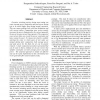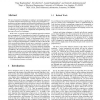5 search results - page 1 / 1 » A Technique to Reduce Peak Current and Average Power Dissipa... |
ASPDAC
2007
ACM
13 years 8 months ago
2007
ACM
Abstract-- In this paper, a technique that can efficiently reduce peak and average switching activity during test application is proposed. The proposed method does not require any ...
VTS
2000
IEEE
13 years 9 months ago
2000
IEEE
Excessive switching activity during scan testing can cause average power dissipation and peak power during test to be much higher than during normal operation. This can cause prob...
MICRO
2009
IEEE
13 years 11 months ago
2009
IEEE
The increasing power dissipation of current processors and processor cores constrains design options, increases packaging and cooling costs, increases power delivery costs, and de...
ICCAD
2001
IEEE
14 years 1 months ago
2001
IEEE
The use of nanometer technologies is making it increasingly important to consider transient characteristics of a circuit’s power dissipation (e.g., peak power, and power gradien...
ISCA
2003
IEEE
13 years 10 months ago
2003
IEEE
Scaling of CMOS technology causes the power supply voltages to fall and supply currents to rise at the same time as operating speeds are increasing. Falling supply voltages cause ...


